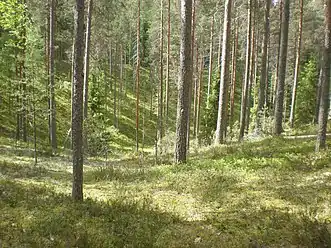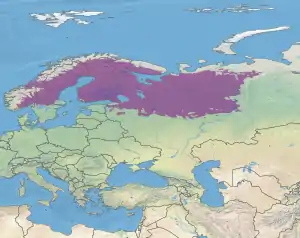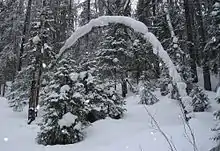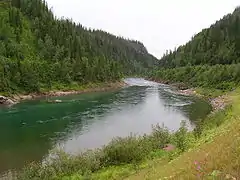Scandinavian and Russian taiga
The Scandinavian and Russian taiga is an ecoregion within the taiga and boreal forests biome as defined by the WWF classification (ecoregion PA0608).[1] It is situated in Northern Europe between tundra in the north and temperate mixed forests in the south and occupies about 2,156,900 km² (832,800 mi²) in Norway, Sweden, Finland and the northern part of European Russia, being the largest ecoregion in Europe. In Sweden the taiga is primarily associated with the Norrland terrain.[2]
 Forest of Pinus sylvestris with an understory of Calluna vulgaris in Leivonmäki National Park, Finland. | |
 Map of ecoregion in northeastern Europe | |
| Ecology | |
|---|---|
| Realm | Palearctic |
| Biome | Taiga |
| Borders | |
| Geography | |
| Area | 2,150,900 km2 (830,500 sq mi) |
Description
The Scandinavian and Russian taiga consists of coniferous forests dominated by Pinus sylvestris (in drier locations), often with an understory of Juniperus communis, Picea abies and Picea obovata and a significant admixture of Betula pubescens and Betula pendula. Larix sibirica is characteristic of the eastern part of the ecoregion. Geobotanically, it belongs to the Northeastern European floristic province of the Circumboreal Region of the Holarctic Kingdom.
The sole vertebrate endemic in this ecoregion is the avian species, razorbill (Alca torda). However, there are a number of special status mammals and birds within the Scandinavian and Russian taiga, as well as one reptilian taxon.[1]
Growing season in taiga areas is generally considered to be measured as the number of days for which average daily temperature exceeds 5 °C (41 °F). The longest growing season for the Scandinavian and Russian taiga occurs in the locales with marine influence from the North Sea and Baltic Sea: in coastal areas of Norway, Sweden and Finland the growing season of the closed boreal forest can reach as high as 145 to 180 days per annum. The shortest growing season of the ecoregion is found in continental Russia and at the far northern part of the ecoregion at the ecotone with tundra.[1]
Soil nutrient levels are generally poor, but diversity of soil organisms can attain high levels, particularly in the southern reaches of the ecoregion. In these southern elements of the ecoregion, closed canopy boreal forest with some temperate deciduous tree species interspersed among the dominant conifers, including maple, elm and oak. In some areas of Norway, Sweden, Finland and western Russia, this zone is exploited for agriculture. Some of the elements of the ecoregion are rich in wetlands, as exemplified by the Femundsmarka National Park in Norway, which is replete with marshes and lakes.[1]
Biodiversity

There are a total of 368 native vertebrate species in the Scandinavian and Russian taiga according to WWF tabulation; when all migratory bird species are included, this number is somewhat larger.[1]
This ecoregion supports the following native non-endemic threatened mammals:[1]
- European mink (Mustela lutreola, Endangered)
- European otter (Lutra lutra, Near Threatened)
- garden dormouse (Eliomys quercinus, Near Threatened)
- Greater noctule bat (Nyctalus lasiopterus, Near Threatened)
- pond bat (Myotis dasycneme, Near Threatened)
- western barbastelle (Barbastella barbastellus, Vulnerable)
- Russian desman (Desmana moschata, Vulnerable)
The Scandinavian and Russian taiga has only a single non-endemic special status native reptile: the Lower Risk grass snake (Natrix natrix).[1]
Native non-endemic threatened avian species in the ecoregion are:[1]
- aquatic warbler (Acrocephalus paludicola, Vulnerable)
- black-tailed godwit (Limosa limosa, Near Threatened)
- Eurasian curlew (Numenius arquata, Near Threatened)
- European roller (Coracias garrulus, Near Threatened)
- great snipe (Gallinago media, Near Threatened)
- greater spotted eagle (Aquila clanga, Vulnerable)
- lesser white-fronted goose (Anser erythropus, Vulnerable)
- pallid harrier (Circus macrourus, Near Threatened)
- red-footed falcon (Falco vespertinus, Near Threatened)
- yellow-breasted bunding (Emberiza aureola, Vulnerable)
Protected areas

The following is a partial list of protected areas lying within the Scandinavian and Russian taiga:[1]
- Björnlandet National Park, Sweden
- Femundsmarka National Park, Norway
- Helvetinjärvi National Park, Finland
- Isojärvi National Park, Finland
- Koli National Park, Finland
- Liesjärvi National Park, Finland
- Muddus National Park, Sweden
- Paanajärvi National Park, Russia
- Skuleskogen National Park, Sweden
- Vodlozersky National Park, Russia
References
-
 This article incorporates text available under the CC BY-SA 3.0 license. Hogan, C. Michael (November 19, 2012). McGinley, Mark (ed.). "Scandinavian and Russian taiga". Encyclopedia of the Earth. Retrieved 2018-12-27.
This article incorporates text available under the CC BY-SA 3.0 license. Hogan, C. Michael (November 19, 2012). McGinley, Mark (ed.). "Scandinavian and Russian taiga". Encyclopedia of the Earth. Retrieved 2018-12-27. - Sporrong, Ulf (2003). "The Scandinavian landscape and its resources". In Helle, Knut (ed.). The Cambridge History of Scandinavia. Cambridge University Press. pp. 22.
- Butzin, Bernhard (1991). "Helsinki — aspects of urban development and planning". GeoJournal. 2 (1): 11–26.
- Moen, A. (1998). Nasjonalatlas for Norge: Vegetasjon (in Norwegian). Hønefoss: Statens Kartverk. ISBN 978-82-90408-26-3.
- Sayre, AP (1994). Taiga. Twenty-First Century Books. ISBN 978-0-8050-2830-0.
Taiga.
- Bolub Bohn, UG; Hettwer, C (2000). Reduced general map of the natural vegetation of Europe (Map). 1:10,000,000. Bonn: Bonn-Bad Godesberg.
- Sjors, H (1999). "Swedish plant geography: The background: Geology, climate and zonation". Acta Phytogeogr. Suec. 84: 5–14.